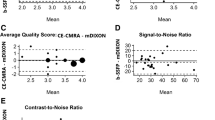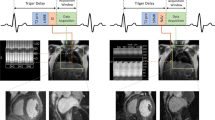Abstract
Objectives
To evaluate a self-navigated free-breathing three-dimensional (SNFB3D) radial whole-heart MRA technique for assessment of main coronary arteries (CAs) and side branches in patients with congenital heart disease (CHD).
Methods
SNFB3D-MRA datasets of 109 patients (20.1±11.8 years) were included. Three readers assessed the depiction of CA segments, diagnostic confidence in determining CA dominance, overall image quality and the ability to freeze cardiac and respiratory motion. Vessel sharpness was quantitatively measured.
Results
The percentages of cases with excellent CA depiction were as follows (mean score): left main, 92.6 % (1.92); left anterior descending (LAD), 88.3 % (1.88); right (RCA), 87.8 % (1.85); left circumflex, 82.8 % (1.82); posterior descending, 50.2 % (1.50) and first diagonal, 39.8 % (1.39). High diagnostic confidence for the assessment of CA dominance was achieved in 56.2 % of MRA examinations (mean score, 1.56). Cardiac motion freezing (mean score, 2.18; Pearson’s r=0.73, P<0.029) affected image quality more than respiratory motion freezing (mean score, 2.20; r=0.58, P<0.029). Mean quantitative vessel sharpness of the internal thoracic artery, RCA and LAD were 53.1, 52.5 and 48.7 %, respectively.
Conclusions
Most SNFB3D-MRA examinations allow for excellent depiction of the main CAs in young CHD patients; visualisation of side branches remains limited.
Key Points
• Self-navigated free-breathing three-dimensional magnetic resonance angiography (SNFB3D-MRA) sufficiently visualises coronary arteries (CAs).
• Depiction of main CAs in patients with congenital heart disease is excellent.
• Visualisation of CA side branches using SNFB3D-MRA is limited.
• SNFB3D-MRA image quality is especially correlated to cardiac motion freezing ability.




Similar content being viewed by others
References
Marelli AJ, Mackie AS, Ionescu-Ittu R, Rahme E, Pilote L (2007) Congenital heart disease in the general population: changing prevalence and age distribution. Circulation 115:163–172
van der Linde D, Konings EEM, Slager MA et al (2011) Birth prevalence of congenital heart disease worldwide: a systematic review and meta-analysis. J Am Coll Cardiol 58:2241–2247
Hoffman JI, Kaplan S (2002) The incidence of congenital heart disease. J Am Coll Cardiol 39:1890–1900
Hoffman JIE, Christianson R (1978) Congenital heart disease in a cohort of 19,502 births with long-term follow-up. Am J Cardiol 42:641–647
Higgins CB, Byrd BF, Farmer DW, Osaki L, Silverman NH, Cheitlin MD (1984) Magnetic resonance imaging in patients with congenital heart disease. Circulation 70:851–860
Gilkeson RC, Ciancibello L, Zahka K (2003) Multidetector CT Evaluation of Congenital Heart Disease in Pediatric and Adult Patients. Am J Roentgenol 180:973–980
Khairy P, Ionescu-Ittu R, Mackie AS, Abrahamowicz M, Pilote L, Marelli AJ (2010) Changing Mortality in Congenital Heart Disease. J Am Coll Cardiol 56:1149–1157
Hoffmann A, Engelfriet P, Mulder B (2007) Radiation exposure during follow-up of adults with congenital heart disease. Int J Cardiol 118:151–153
Bacher K, Bogaert E, Lapere R, De Wolf D, Thierens H (2005) Patient-specific dose and radiation risk estimation in pediatric cardiac catheterization. Circulation 111:83–89
Ait-Ali L, Andreassi MG, Foffa I, Spadoni I, Vano E, Picano E (2010) Cumulative patient effective dose and acute radiation-induced chromosomal DNA damage in children with congenital heart disease. Heart 96:269–274
Renker M, Varga-Szemes A, Schoepf UJ et al (2016) A non-contrast self-navigated 3-dimensional MR technique for aortic root and vascular access route assessment in the context of transcatheter aortic valve replacement: proof of concept. Eur Radiol 26:951–958
Beerbaum P, Sarikouch S, Laser K-T, Greil G, Burchert W, Körperich H (2009) Coronary anomalies assessed by whole-heart isotropic 3D magnetic resonance imaging for cardiac morphology in congenital heart disease. J Magn Reson Imaging 29:320–327
Boffano C, Chiribiri A, Cesarani F (2009) Native whole-heart coronary imaging for the identification of anomalous origin of the coronary arteries. Int J Cardiol 137:e27–e28
Hussain T, Lossnitzer D, Bellsham-Revell H et al (2012) Three-dimensional Dual-Phase Whole-Heart MR Imaging: Clinical Implications for Congenital Heart Disease. Radiology 263:547–554
Uribe S, Hussain T, Valverde I et al (2011) Congenital Heart Disease in Children: Coronary MR Angiography during Systole and Diastole with Dual Cardiac Phase Whole-Heart Imaging. Radiology 260:232–240
Kato S, Kitagawa K, Ishida N et al (2010) Assessment of Coronary Artery Disease Using Magnetic Resonance Coronary Angiography: A National Multicenter Trial. J Am Coll Cardiol 56:983–991
Bonnichsen C, Ammash N (2016) Choosing Between MRI and CT Imaging in the Adult with Congenital Heart Disease. Curr Cardiol Rep 8:1–10
Henningsson M, Hussain T, Vieira MS et al (2016) Whole-heart coronary MR angiography using image-based navigation for the detection of coronary anomalies in adult patients with congenital heart disease. J Magn Reson Imaging JMRI 43:947–955
Piccini D, Monney P, Sierro C et al (2014) Respiratory Self-navigated Postcontrast Whole-Heart Coronary MR Angiography: Initial Experience in Patients. Radiology 270:378–386
Stuber M, Weiss RG (2007) Coronary magnetic resonance angiography. J Magn Reson Imaging JMRI 26:219–234
Abdalla EK, Bauer TW, Chun YS, D’Angelica M, Kooby DA, Jarnagin WR (2013) Locoregional surgical and interventional therapies for advanced colorectal cancer liver metastases: expert consensus statements. HPB 15:119–130
Piccini D, Littmann A, Nielles-Vallespin S, Zenge MO (2012) Respiratory self-navigation for whole-heart bright-blood coronary MRI: Methods for robust isolation and automatic segmentation of the blood pool. Magn Reson Med 68:571–579
Stehning C, Börnert P, Nehrke K, Eggers H, Stuber M (2005) Free-breathing whole-heart coronary MRA with 3D radial SSFP and self-navigated image reconstruction. Magn Reson Med 54:476–480
Piccini D, Feng L, Bonanno G et al (2016) Four-dimensional respiratory motion-resolved whole heart coronary MR angiography: Respiratory Motion-Resolved Coronary MRA. Magn Reson Med 77:1473–1484
Monney P, Piccini D, Rutz T et al (2015) Single centre experience of the application of self navigated 3D whole heart cardiovascular magnetic resonance for the assessment of cardiac anatomy in congenital heart disease. J Cardiovasc Magn Reson 17:55
Kim WY, Danias PG, Stuber M et al (2001) Coronary magnetic resonance angiography for the detection of coronary stenoses. N Engl J Med 345:1863–1869
Piccini D, Littmann A, Nielles-Vallespin S, Zenge MO (2011) Spiral phyllotaxis: The natural way to construct a 3D radial trajectory in MRI. Magn Reson Med 66:1049–1056
Etienne A, Botnar RM, Muiswinkel V et al (2002) “Soap-Bubble” visualization and quantitative analysis of 3D coronary magnetic resonance angiograms. Magn Reson Med 48:658–666
Wichmann JL, Gillott MR, De Cecco CN et al (2016) Dual-Energy Computed Tomography Angiography of the Lower Extremity Runoff: Impact of Noise-Optimized Virtual Monochromatic Imaging on Image Quality and Diagnostic Accuracy. Invest Radiol 51:139–146
Al-Kwifi O, Stainsby J, Foltz WD, Sussman MS, Huang Y, Wright GA (2006) Characterizing coronary motion and its effect on MR coronary angiography—Initial experience. J Magn Reson Imaging 24:842–850
Pang J, Sharif B, Fan Z et al (2014) ECG and navigator-free four-dimensional whole-heart coronary MRA for simultaneous visualization of cardiac anatomy and function: Self-Gated 4D Coronary Imaging. Magn Reson Med 72:1208–1217
Coppo S, Piccini D, Bonanno G et al (2015) Free-running 4D whole-heart self-navigated golden angle MRI: Initial results: Free-Running 4D Whole-Heart MRI. Magn Reson Med 74:1306–1316
Piccini D, Bonanno G, Ginami G, Littmann A, Zenge MO, Stuber M (2016) Is there an optimal respiratory reference position for self-navigated whole-heart coronary MR angiography?: Optimal Respiratory Reference for Coronary MRA. J Magn Reson Imaging 43:426–433
Ginami G, Bonanno G, Schwitter J, Stuber M, Piccini D (2016) An iterative approach to respiratory self-navigated whole-heart coronary MRA significantly improves image quality in a preliminary patient study: Iterative Approach to Respiratory Self-Navigation. Magn Reson Med 75:1594–1604
Pang J, Bhat H, Sharif B et al (2014) Whole-heart coronary MRA with 100% respiratory gating efficiency: Self-navigated three-dimensional retrospective image-based motion correction (TRIM): Image-Based Motion Correction for Whole-Heart CMRA. Magn Reson Med 71:67–74
He Y, Pang J, Dai Q, Fan Z, An J, Li D (2016) Diagnostic Performance of Self-navigated Whole-Heart Contrast-enhanced Coronary 3-T MR Angiography. Radiology 281:401–408
Tangcharoen T, Bell A, Hegde S et al (2011) (2011) Detection of Coronary Artery Anomalies in Infants and Young Children with Congenital Heart Disease by Using MR Imaging. Radiology 259:240–247
Author information
Authors and Affiliations
Corresponding author
Ethics declarations
Guarantor
The scientific guarantor of this publication is Prof. Dr. U. Joseph Schoepf.
Conflict of interest
The authors of this manuscript declare relationships with the following companies: U. Joseph Schoepf is a consultant for and/or receives research support from Astellas, Bayer, Bracco, GE, and Siemens. Carlo N. De Cecco is a consultant for and/or receives research support from Guerbet and Siemens. Akos Varga-Szemes is a consultant for Guerbet. Davide Piccini is an employee of Siemens Healthcare.
The other authors of this manuscript declare no relationships with any companies whose products or services may be related to the subject matter of the article.
Funding
Part of this research was funded by the Swiss National Science Foundation Grant SNF 320030_143923.
Statistics and biometry
One of the authors has significant statistical expertise.
Ethical approval
Institutional Review Board approval was obtained.
Informed consent
Written informed consent was waived by the Institutional Review Board.
Methodology
• retrospective
• observational
• performed at one institution
Rights and permissions
About this article
Cite this article
Albrecht, M.H., Varga-Szemes, A., Schoepf, U.J. et al. Coronary artery assessment using self-navigated free-breathing radial whole-heart magnetic resonance angiography in patients with congenital heart disease. Eur Radiol 28, 1267–1275 (2018). https://doi.org/10.1007/s00330-017-5035-1
Received:
Revised:
Accepted:
Published:
Issue Date:
DOI: https://doi.org/10.1007/s00330-017-5035-1




